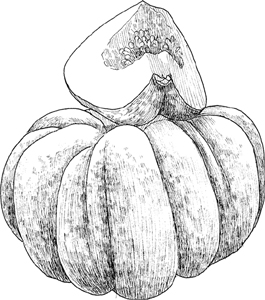
BOTANICAL NAME: Cucurbita maxima
FAMILY: Cucurbitaceae

Chioggia is both the scene of a great sea battle important to Venetian history and the site of an ancient fishing town where today Venetians flee to escape the tourist cuisine endemic to their own local restaurants. The fresh vegetables sold in the canal-side markets of Venice were most likely loaded onto barges in Chioggia. On rare occasion, and only in Chioggia, it is still possible to see the old-style Venetian fishing boats, with their colorful triangular sails plying the still waters of the Adriatic. Chioggia is a symbol of old Venetian culture; thus anything dubbed Chioggian carries with it an added cultural significance. The Zucca Marina di Chioggia (pronounced zooka ma-REE-na dee kee-OH-ja) or Chioggia sea pumpkin is therefore an historic relic and a culinary treasure. It is something essentially Venetian, and Venetians fondly refer to it in their dialect as zucca barucca.
When Venice lost its colonial possession of Cyprus to the Turks in 1572, it could no longer derive wealth from the lost sugar plantations it established there in the Middle Ages. Thus the terra firma, the great backlands of the Veneto, became the new focus of the Venetian economy. This agricultural shift resulted in the proliferation of Palladian villas that changed the course of European art history, but in the fields new things were also happening. The sea pumpkin, introduced from the Americas in the 1600s, took root and over the ensuing centuries developed into a distinctive Venetian variety.
There are two, perhaps three, fall pumpkins that are grown under the name of the Chioggia sea pumpkin. Back in the 1970s, I acquired seed in Castelfranco for a strain that was heavily lobed (as appears in the illustration) but with blue-black skin. This is the sea pumpkin mentioned by Italian botanist Ottavio Tozetti in 1809. This is also the pumpkin I saw sold from barges in Venice. The bargemen sliced and grilled it with olive oil over braziers. The foggy fall air of every Venetian morning is still laden with the rich aroma of these pumpkins, which are sold by the slice as a canal-side street food.
Then there is a Chioggia pumpkin of similar shape, but with a dark green skin, and, finally, a warty gray-green one shaped like a Japanese squash with a small “turban” protruding from the blossom end. The most authentic is the one with blue-black skin, for it has rich, salmon-orange flesh with a flavor that is incomparable and fully necessary to complete the list of ingredients for proper Venetian tortelli (half-moon dumplings made with pasta dough). These are tortelli stuffed with cooked, pureed pumpkin, except that every family has its own elusive condiment to enrich the mixture. There are mostarde (mustard-flavored pickles) made of preserved apricots, cherries, pears, and even pine nuts. I think the stuffing made with half pumpkin and half green figs cooked in wine and pureed needs no further garnish than a glass of exquisite Venetian pinot grigio and perhaps a side dish of grilled squid.